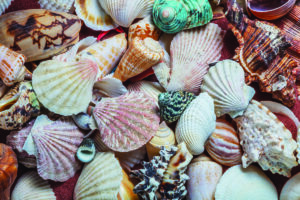(Editor’s note: DeeDee Wood is the owner of Black Cat Curiosities, an online antiques research and sales venue.)
You might be walking down the beach this summer and stop to consider a shell that has just washed up from out of the surf at your feet.
Shell collecting and display is part of the “antiques world,” as antique shells can be found in the world markets, and some people put them in what was once termed a cabinet of curiosity.
From ancient times to Victorian Europe, collectors have always been fascinated by these objects that spawn from the sea, with geographical histories, rarity of specimens and display value. 
Shell collecting dates back to the Stone Age. Archaeologists have found shells in digs sites around the world, indicating shells and things made out of these ocean crustations were used for embellishments, ancient jewelry, and ocean trading, such as collections of mollusks found arranged in such a way as indicating their value as a tradable item that had importance to the community who collected them, showing merit.
The term “conchology” means the study of the mollusk shells. Antique collectors and conchologists are different, in some viewpoints, because to collect and appreciate shells that were part of “cabinets of curiosities” or specimens for display, is a different past time then collecting for scientific documentation and observation, although displays and appreciation cross over in both of these worlds.
During the 15th and 16th centuries in Europe, an age that encompassed the Reinassance period, shells were collected as an object of wonder and beauty, and often put into something we coined as a term today as a “cabinet of curiosity,” or a collection of wonderous things that promoted ideas of a world not fully grasped or explored, such as the ocean and the depths and creatures that dwelled within that watery world. Shells, gemstones, bones and other items of a man-made origin could be found in these cabinets, or in other displays of the wonder of the natural or ancient world.
Going forward into the 17th century and beyond, all over the world shells were studied and documented, as an attempt was made to classify them and determine their importance in the natural world.
During this time period, volumes of research efforts were published, as well as the initiation of the growing interest in a shell as a thing of beauty, or something to be utilized as décor display, jewelry embellishment and amateur collection and study of something rare and beautiful.
During this time period plates and engravings can be found that show the attempts at study, as the line of study and appreciation begin to blur together into the notion of a modern-day shell collector.
The height of the shell collecting world as a hobby and curiosity would reach England in the late 18th and early to middle 19th centuries, as the rapid opening of trade routes and world exploration ensued with better travel options and the railway systems opening up routes.
Pacific and island trade ensued, and specimens rarely seen reached collector markets, opening up even more curiosities and specimen display and appreciation.
Shell auctions and high prices reached a fevered pitch during this time period, as rare ones came onto the market for perusal. As well, during this time period of the 18th and early 19th centuries, with the rapid change that brought the shells into common viewing, the change also caused areas of harvesting to become exploited, and the market offered once rare shells at a more common rate, causing the decline of the initial, explosive interest.
Collecting shells, especially vintage ones, or cabinet of curiosity 19th century shells, is really at the whim of a collector’s preference.
There are around 100,000 known shell species, with limitless places in the world from which they are collected. Shells are also a good thing to collect due to the endurance of condition, as the make up and consistency of shells causes the shelf life and condition to be good for many years.
Shells weren’t just collected in a single fashion and displayed. Shells, which can be seen in many antique pieces, involve using them in not only jewelry, but artwork.
Victorian shell boxes, mirror surrounds of shell, oyster plates, spoon holders and more can be seen in abundance in the antiques market.
There is a whole genre of antiques that involve a nautical theme, with various objects adorned in shells, such as sailor art that had intricate shell patterns and boxes covered in clever shell design schemes. Many of these types of items made it into the specialized cabinets of curiosity for collectors of the past.
Shell collecting and shells in general, have laws regarding their collection and ownership, according to regions and laws regarding natural collections of species and more.
Before starting a collection of your own, or buying anything nautical or shell related from the past, it is best to check on laws regarding anything that was once a living creature.
Rarity, endangerment laws, and rules of specific countries and collection methods must be considered.
Shell collections from the past offer a glimpse into the world of considering an object that we think commonplace today, as a seashell, as a representation of a valuable trade item, exotic nuance of a foreign sea, concepts of a vast ocean, and the wonderment that cabinets of curiosity, anything curious, represents.
Diving into the world of antique shells and collecting offers the collector, with proper research, a world that started from the Stone Age, and continues today.



